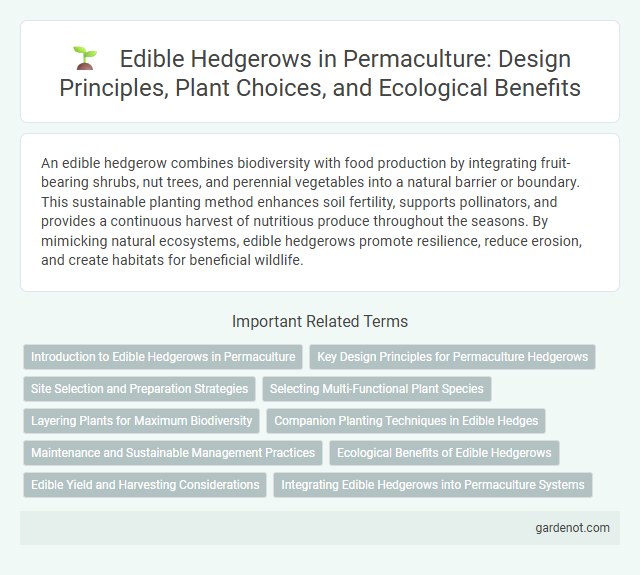An edible hedgerow combines biodiversity with food production by integrating fruit-bearing shrubs, nut trees, and perennial vegetables into a natural barrier or boundary. This sustainable planting method enhances soil fertility, supports pollinators, and provides a continuous harvest of nutritious produce throughout the seasons. By mimicking natural ecosystems, edible hedgerows promote resilience, reduce erosion, and create habitats for beneficial wildlife.
Introduction to Edible Hedgerows in Permaculture
Edible hedgerows in permaculture serve as multifunctional boundary systems that combine food production with ecological benefits such as soil improvement, habitat creation, and natural pest control. These plantings typically include a diverse mix of fruit-bearing shrubs, nut trees, nitrogen-fixing plants, and herbs that support biodiversity and enhance nutrient cycling. Integrating edible hedgerows boosts landscape resilience and provides continuous yields while promoting sustainable land management practices.
Key Design Principles for Permaculture Hedgerows
Edible hedgerows in permaculture integrate diverse, multifunctional plant species to maximize food production, biodiversity, and ecosystem services within limited space. Key design principles emphasize layering plant heights, including nitrogen-fixing shrubs, fruit-bearing trees, and perennial herbs to enhance soil fertility and attract beneficial insects. Strategic placement considers sun exposure, windbreak functions, and water management to create resilient, self-sustaining agroecosystems.
Site Selection and Preparation Strategies
Optimal site selection for an edible hedgerow prioritizes well-drained soil with full to partial sunlight exposure to maximize plant growth and fruit production. Preparation strategies include soil testing to amend pH and nutrient levels, incorporating organic matter such as compost to enhance fertility, and removing invasive species or debris to reduce competition. Installing swales or contour planting can improve water retention and prevent erosion, supporting long-term sustainability of the edible hedgerow system.
Selecting Multi-Functional Plant Species
Selecting multi-functional plant species for an edible hedgerow enhances biodiversity and maximizes yields by combining fruit, nuts, and nitrogen-fixing plants that improve soil fertility. Incorporating species such as Goumi berry, Siberian pea shrub, and hazelnut creates a resilient ecosystem that provides food, wildlife habitat, and natural pest control. This approach ensures a sustainable permaculture design with diverse harvests and improved land productivity.
Layering Plants for Maximum Biodiversity
Edible hedgerows utilize strategic layering of plants, combining ground covers, shrubs, and trees to maximize biodiversity and yield. Integrating nitrogen-fixing species, fruit-bearing bushes, and perennial herbs creates resilient ecosystems that support beneficial insects and improve soil health. This vertical and functional diversity enhances productivity while promoting sustainable, regenerative agricultural practices.
Companion Planting Techniques in Edible Hedges
Edible hedgerows utilize companion planting techniques to enhance growth, pest control, and soil health by combining species with complementary traits, such as nitrogen-fixing shrubs alongside fruiting plants. Planting dynamic accumulators like comfrey attracts beneficial insects while improving nutrient cycling, creating a resilient ecosystem within the hedge. Strategic layering of herbs, flowers, and edible shrubs maximizes space, biodiversity, and yields in permaculture edible hedges.
Maintenance and Sustainable Management Practices
Regular pruning and selective harvesting maintain the health and productivity of edible hedgerows, preventing overgrowth and promoting fruit and nut yield. Integrating organic mulching and natural pest control methods supports soil fertility and biodiversity, enhancing long-term sustainability. Seasonal monitoring optimizes plant vigor and ensures resilience against environmental stressors in permaculture systems.
Ecological Benefits of Edible Hedgerows
Edible hedgerows support biodiversity by providing habitat and food sources for pollinators, birds, and beneficial insects, enhancing ecosystem resilience. They improve soil health through natural nitrogen fixation and organic matter accumulation, reducing the need for synthetic fertilizers. These hedgerows act as windbreaks and water filters, minimizing erosion and runoff while promoting sustainable land management in permaculture systems.
Edible Yield and Harvesting Considerations
Edible hedgerows provide a diverse and sustainable yield of fruits, nuts, berries, and herbs that support food security and biodiversity in permaculture systems. Harvesting considerations include timing for peak ripeness to maximize flavor and nutrient content, along with techniques to minimize plant stress and encourage continual production. Strategic pruning and selective harvesting help maintain plant health and promote regenerative growth, ensuring a consistent and abundant edible yield.
Integrating Edible Hedgerows into Permaculture Systems
Integrating edible hedgerows into permaculture systems enhances biodiversity by providing habitat for beneficial insects and wildlife. These living fences offer multiple functions, including producing fruits, nuts, and herbs while improving soil health through nitrogen fixation and erosion control. Strategically placed edible hedgerows increase ecosystem resilience and contribute to sustainable food production within permaculture landscapes.
Edible hedgerow Infographic

 gardenot.com
gardenot.com